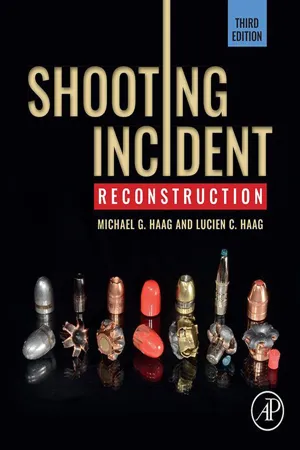
- 580 pages
- English
- ePUB (mobile friendly)
- Available on iOS & Android
Shooting Incident Reconstruction
About This Book
Shooting Incident Reconstruction, Third Edition, offers a thorough explanation of matters from simple to complex to help the reader understand the factors surrounding ballistics, trajectory, and shooting scenes.
Forensic scientists, law enforcement, and crime scene investigators are often tasked with reconstruction of events based on crime scene evidence, along with the subsequent analysis of that evidence. The use and misuse of firearms to perpetrate crimes from theft to murder necessitates numerous invitations to reconstruct shooting incidents. The discharge of firearms and the behavior of projectiles create many forms of physical evidence that, through proper testing and interpretation by a skilled forensic scientist, can establish what did and what did not occur.
Written by the world's most well-respected shooting scene and ballistics experts, the book addresses the terminology, science, and factors involved in reconstructing shooting incident events to solve forensic cases. It covers the full range of related topics including: the range from which a firearm was discharged; the sequence of shots in a multiple discharge shooting incident; the position of a firearm at the moment of discharge; and the position of a victim at the moment of impact. The probable flight path of a projectile and the manner in which a firearm was discharged are also discussed. Case studies illustrate real-world application of technical concepts, supported by over 200 full-color diagrams and photographs.
This book will be of value to practicing forensic scientists (firearm and toolmark examiners), ballistics experts, crime scene personnel, police departments, forensic consultants (generalists), attorneys and judges, medical examiners (coroners), and forensic pathologists.
- New chapters on special reconstructive properties and value of shootings involving sub-machine guns or pseudo automatic firearms, rate of fire with special attention on shot-to-shot time intervals, human factors in shooting incidents
- Updated and revised glossary terms to fit with new technology and the emergence of standardization of terms by groups such as the Organization of Scientific Advisory Committees
- Provides clear practice standards and ethical guidelines for those involved in reconstructing shooting scenes
Frequently asked questions
Information
Table of contents
- Cover image
- Title page
- Table of Contents
- Copyright
- Dedication
- Acknowledgement
- Introduction to the third edition of Shooting Incident Reconstruction
- Chapter 1. Case approach, philosophy, and objectives
- Chapter 2. Working shooting scenes
- Chapter 3. The reconstructive aspects of class characteristics and a limited universe
- Chapter 4. Suspected bullet impact sites and bullet holes
- Chapter 5. Some useful reagents and their application
- Chapter 6. The principles of “trajectory” reconstruction
- Chapter 7. The shooting of motor vehicles
- Chapter 8. Distance and orientation derived from gunshot residue patterns
- Chapter 9. Projectile penetration and perforation
- Chapter 10. The reconstructive value of cartridge cases, the cycle of fire, and ejection patterns
- Chapter 11. Projectiles and glass
- Chapter 12. Projectile ricochet and deflection
- Chapter 13. Shotgun shootings and evidence
- Chapter 14. Wound ballistic properties and bullet behavior/bullet track (“trajectory”) determinations in gunshot wounds
- Chapter 15. Trace evidence considerations associated with firearms evidence
- Chapter 16. True ballistics: long-range shootings and falling bullets
- Chapter 17. The sound levels of gunshots, supersonic bullets, and other impulse sounds
- Chapter 18. Ultimate objectives, reports, and court presentation
- Appendix 1. Shooting Incident Evaluation and Reconstruction
- Glossary
- Index